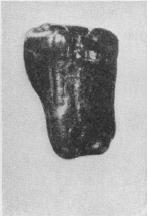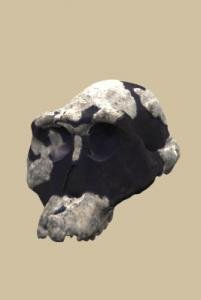Trying to find out where we come from. Nothing more, nothing less.
Unfortunately the answers to our origins and purpose does not lie in fossilized specimens that are often either mis-classified intentionally or unintentionally by scientists with highly over-active imaginations.
We can accept that everything that we see around us has a developer/ 'maker' who is identifiable and who provides an instruction manual for the use of the item.
Yet, when it comes to the development of the universe and ourselves, we find it difficult to believe that our Creator has indeed identified Himself and that He has sent down revelation to teach us about Himself, our origins and purpose.
What I don't like is the savagery exhibited by some creationists as they try to discredit evolution. It's dishonest, illogical and counter-factual.
Thus far, all that has been shown to be 'dishonest, illogical and counter-factual', has come from the evolutionists corner.
- There are multiple examples of either fake or mis-classified fossils in attempts to bridge the gaps in TOE. (Dishonest)
- There is no biologically plausible explanation for the process of evolution to occur, at all. (Illogical)
- Not a single creature has been observed to be in the phases of evolving into a completely new species. (Counter-factual)
I will refer to this methodology as 'D.I.C' from now on.
"It seems too complicated so I don't believe it." That's not an argument.
Im yet to hear a creationist make this argument.
Our arguments are based on 'D.I.C'.
T
Nebraska Man
Here's how Foard describes him:
The twentieth century is full of dethroned "ape-men" who never existed outside of evolutionist imagination, such as Nebraska Man, a pig
Contrary to the impression given here, Nebraska Man was never widely accepted as a proven hominid and rejected altogether after 5 years. The only reason anyone remembers it is because its preserved in Creationist literature //
To summarise:
1. Nebraskan Man is in no way an example of an anti religion agenda or deliberate fraud.
2. Osborn himself was a decent man who was very pro Christian. The mistake he made was sincere.
3. The mistake itself was not as great as suggested. He never called the fossil a man, and even at the peak of his error regarded it as a previously unknown primate.
4. To describe the fossil as simply 'a pig' as Foard does is deceptive, it sounds like farmyard remains. In fact it dates from long before any farmyard ever existed. It is a genuine fossil but that of a peccary, a pig ancestor (which does have some resemblance to human teeth although it should not have been mistaken). It's also not true that Osborn called him an 'ape man'. All of this comes from Foard (or rather, it's repeated by Foard from other Creationist sources.)
5. The scientific reception was cautious and it never achieved acceptance. Within a short timescale for a pre internet period, the fossil was decisively rejected.
6. It played no part in mainstream evolutionary thinking then or now.
7. Even the name and the ever popular illustration had nothing to do with evolution.
Far from occupying a key place in the 'evolutionist imagination' as Foard calls it, the fossil in fact has achieved fame and immortality only in the imagination of Creationists.
Thanks for the lovely story behind the Nebraska
pig.
An alternative summary:
1. Before any scientific information/ 'evidence' is released for public consumption, it remains the responsibility of the investigators to verify, and then re-verify, their findings.
2. Its difficult enough to identify an animal from a single tooth.
Let alone an
extinct species. This in itself indicates how ridiculous the entire premise was.
3. When Cook wrote to Osborn, he said that he had found a tooth “that very closely approaches the human type.”:
This is the tooth:
This was Osborns initial reaction:
"The instant your package arrived, I sat down with the tooth, in my window, and I said to myself: “It looks one hundred per cent anthropoid.”
Amazingly, from this one tooth, they came to this conclusion:
"The analysis by the three scientists supported the ape as an intermediate offshoot between Dryopithecus, the hypothesized ancestor of the living African apes, and Sivapithecus, a fossil ape from Asia close to our own lineage."
and they already gave a name to this imaginary genus: “Hesperopithecus” .
4. It took 5 years to finally put this case to rest because:
"In 1923 Gregory and Hellman wrote a second paper to defend the hypothesis that Hesperopithecus was truly a fossil ape.
^
This is not a mistake.
This is called intentional deception and fraud.
I have repeatedly said that all fossils are evidence for TOE in the sense that no fossil yet found contradicts the overall logic and pattern (although of course they revise the detail). If you think one does, tell us.
I am no better at posting links to fossil websites than you. But if it makes you happy, this one is pretty:
http://humanorigins.si.edu/evidence/3d-collection
You have linked us to a site with pictures of skulls.....I stopped at the first 'fossil evidence': A.L 444-2
It says:
[TABLE="class: views-view-grid col-2"]
[TR="class: row-1 row-first row-last"]
[TD="class: col-1 col-first"]This large male skull was found at the same locality as the famous Lucy skeleton. It is much bigger than the skull of Lucy and other females of this species, indicating there were differences in body size between the sexes.
Australopithecus afarensis [/TD]
[TD="class: col-last"]
[/TD]
[/TR]
[/TABLE]
^ The fact that they can still reference "Lucy" - a fossil that was shown to belong to a
chimpanzee, and continue to classify it as well as this specimen under the fancy name of Australopithecus afarensis, tells us alot.
It is evident that you have no idea of any genuine 'fossil evidences', yet you continue to promote this false science to others?
Just out of interest, here is the pic of AL 444-2:
^ Theres more missing parts to this skull than the black synthetic material used to fill it in.
Exactly how this specimen (and the others like it) can fall anywhere along the development lines of man remains a mystery to those who give thought.
Evolution is simple in essence, those animals better suited to their environments survive and thrive. Those that aren't, die. It's been said over, and over, and over in this thread that evolution does not have all the answers, but it has a lot of evidence to point us in the right direction. At the end of the day, you either trust what scientists are telling us (99% of scientists) or you don't. You clearly don't.
Why do elephants have trunks? Because it conferred an advantage upon their ancestors and they received the trait. Why are some animals carnivores? Likewise. There is no special reason with evolution - things are as they are because they helped animals live and therefore breed.
^ Would you mind referencing your many claims?
- What 'evidence' is there that 'points us in the right direction'?
- '99% of scientists' are telling us that evolution is true? - Where did you obtain these stats? This is simply not true.
- What do you actually mean in your last paragraph? - It makes no biological sense at all. How would this actually occur?
TOE predicts that, in the fullness of time, all available possibilities and niches will be explored. If you look at the world you find creatures not just in lush, easy environments but also the most extreme cold, hot, wet, dry, deep or shallow places. Absolutely everywhere possible. Many people make the mistake of thinking that evolution is on a course to 'higher' organisms (ultimately man). It isn't. It's simply filling all spaces available, whether that works with complex or simple creatures.
How does an uninstructed, unsupervised system predict this?
Does this occur by chance? ......to result in the balanced, perfect order that we see today?
[TABLE="class: wikitable"]
[TR]
[/TR]
[TR]
[TD="align: right"][/TD]
[TD][/TD]
[/TR]
[TR]
[TD="align: right"][/TD]
[TD][/TD]
[/TR]
[TR]
[TD="align: right"][/TD]
[TD][/TD]
[/TR]
[TR]
[TD="align: right"][/TD]
[TD][/TD]
[/TR]
[/TABLE]
The phylogenetics, the chronology, the geology etc etc. This is why most scientists are sure evolution has in fact taken place.
For those who may not be well versed in scientific terminology:
'phylogenetics': "The result of phylogenetic studies is a
hypothesis about the evolutionary history of taxonomic groups" (wikipedia)
^ Its all hypothesis, and will always remain so.
Lets not make it into fact as has been attempted numerously in this thread.
You cant expect us to base our beliefs and our lives on a hypothesis at best.
'chronology': The science that deals with the determination of dates and the sequence of events.
As will be shown in the next post, this too is hypothesis.
In short, nothing in this pseudo-science of evolution is verifiable, reproducible, logical or follows basic principles of investigation and science.
If it does, it still is in the 'hypothesis' phase - a very imaginative hypothesis.....with highly questionable attempts to back it up by 'evidence'.
But the 'how' of evolution is not a finished subject. Creationists focus on the problems. They won't accept TOE until the how is complete in every detail, until every last 't' is crossed and 'i' is dotted.
We are not even focusing on the
details of the 'how' of evolution.
Even the broad theoretical principles for evolution to occur are not biologically feasible, not reproducible.....in fact, impossible.
Please refer to previous posts for this discussion.
.
No, it's the constant rolling of the dice that discovers new forms.
I cant believe you have even said this.
With the types of answers we are receiving in this thread, how are we expected to take anything in evolution seriously?
جوري;1605148 said:
Just useless words to describe your feelings and no science whatsoever..
This isn't the first grade where you're meant to describe what you see..
best,
Couldn't agree more sister.




